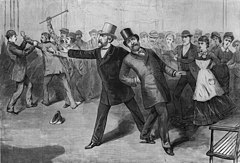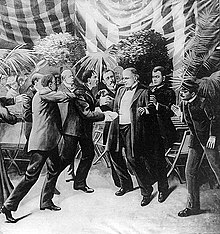List of presidents of the United States who died in office
[5] Sixteen years later, on July 2, 1881, James A. Garfield was shot by Charles J. Guiteau, surviving for 79 days before dying on September 19, 1881.
[8] On April 12, 1945, Franklin D. Roosevelt (who had just begun his fourth term in office) collapsed and died as a result of a cerebral hemorrhage.
[9] The most recent U.S. president to die in office was John F. Kennedy, who was shot by Lee Harvey Oswald on November 22, 1963, in Dallas, Texas.
[11] After making a diagnosis of right lower lobe pneumonia, they proceeded to place heated suction cups on his bare torso and to administer a series of bloodlettings, to supposedly draw out the disease.
[12] When those procedures failed to bring about improvement, the doctors treated him with ipecac, Castor oil, calomel, and finally with a boiled mixture of crude petroleum and Virginia snakeroot.
By the end of the month large crowds were gathering outside the White House, holding vigil while awaiting any news about the president's condition.
[12] His last words were to his attending doctor, though assumed to be directed at Vice President John Tyler: Sir, I wish you to understand the true principles of the government.
An invitation-only funeral service was also held, on April 7, in the East Room of the White House, after which Harrison's coffin was brought to Congressional Cemetery in Washington, D.C., where it was placed in a temporary receiving vault.
Also sometimes referred to as the Zero Factor legend, the pattern was disrupted by Ronald Reagan, who survived an assassination attempt in 1981 (69 days after taking office) and lived to complete two full terms.
[18] Zachary Taylor was known to have consumed copious amounts of ice water, cold milk, green apples, and cherries on July 4, 1850, after attending holiday celebrations and the laying of the cornerstone of the Washington Monument.
[23] Afterward, an estimated 100,000 people gathered along the funeral route[20] to Congressional Cemetery where his coffin was placed temporarily in the Public Vault; that October it was transported to Louisville, Kentucky.
[25] The cause of Taylor's death was definitively established in 1991, when his remains were exhumed and an autopsy conducted by Kentucky's chief medical examiner.
Subsequent neutron activation analysis conducted at Oak Ridge National Laboratory revealed no evidence of poisoning, as arsenic levels were too low.
[26][27] The analysis concluded Taylor had contracted cholera morbus (acute gastroenteritis), as Washington had open sewers, and his food or drink may have been contaminated.
[32] Booth and a group of co-conspirators originally plotted to kidnap Lincoln, but later planned to kill him, Vice President Andrew Johnson, and Secretary of State William H. Seward in a bid to help the Confederacy's cause.
[36][37] Within two weeks of the manhunt for Lincoln's killers, on April 26, 1865, Booth and David Herold were caught in a tobacco barn in Port Conway, Virginia.
[39] On that day, Guiteau lay in wait for the president at the Baltimore and Potomac Railroad station, on the southwest corner of present-day Sixth Street and Constitution Avenue NW, Washington, D.C.[40] President Garfield came to the Sixth Street Station on his way to his alma mater, Williams College, where he was scheduled to deliver a speech.
[42] As President Garfield entered the waiting room of the station, Guiteau stepped forward and pulled the trigger from behind at point-blank range.
[43] One bullet grazed Garfield's shoulder; the other hit him in the back, passing the first lumbar vertebra but missing the spinal cord before coming to rest behind his pancreas.
[52] Garfield had been a regular visitor to the shore town of Long Branch, New Jersey, one of the nation's premier summer vacation spots until World War I.
Arthur took the presidential oath of office, administered by a New York Supreme Court judge, then left for Long Branch to pay his respects before traveling on to Washington.
[55] When the tracks that had been hastily built to the Franklyn cottage were later torn up, actor Oliver Byron bought the wooden ties, and had local carpenter William Presley build them into a small tea house, in commemoration of the president.
[57] The secretary to the president, George B. Cortelyou, feared an assassination attempt would take place during a visit to the Temple of Music, and twice took it off the schedule.
[58] Czolgosz had lost his job during the economic Panic of 1893 and turned to anarchism, a political philosophy whose adherents had previously killed foreign leaders.
[7] McKinley initially appeared to be recovering, but took a turn for the worse on September 13 as his wounds became gangrenous, and died early the next morning; Vice President Theodore Roosevelt succeeded him.
[61] After McKinley's murder, for which Czolgosz was put to death in the electric chair, the United States Congress passed legislation to officially charge the Secret Service with the responsibility for protecting the president.
[62] Warren G. Harding died from a sudden heart attack in his hotel suite while visiting San Francisco on the evening of August 2, 1923, at the age of 57.
[65] On March 29, 1945, Franklin D. Roosevelt went to the Little White House in Warm Springs, Georgia, to rest before his anticipated appearance at the founding conference of the United Nations in late April in San Francisco.
President Harry S. Truman dedicated Victory in Europe Day and its celebrations to Roosevelt's memory, and kept the flags across the U.S. at half-staff for the remainder of the 30-day mourning period.
Parties as varied as the CIA, the Mafia, the Cuban and the Soviet governments, along with Kennedy's successor, Lyndon Johnson, have been identified as Suspect.







